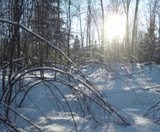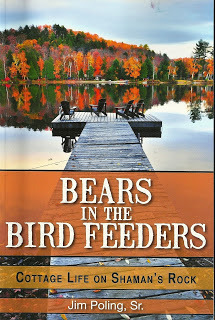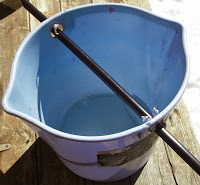Jim Poling Sr.'s Blog, page 47
January 10, 2014
"Packt Like Sardines In A Crushd Tin Box"
For those of us who fly tourist class, the days of comfort are but a vapour trail. Airline travel is going through a revolution that dictates less passenger comfort and promises more discomfort to come.
 Sardines in a Tin News channels have been bursting with horror stories about cancellations and delays brought by this winter’s freakish weather. Those are just sporadic, temporary horrors, however. What’s going on inside commercial airplanes is producing agonies that are becoming the norm. The space between airline seats is shrinking and will shrink more. The New York Times reported recently that the space between seats has fallen roughly 10 per cent in the last 20 years from 34 inches (which was not huge), to an average 30 to 32 inches. Budget operation Spirit Airlines has reduced it’s between-seats space to 28 inches. Besides reducing seating space some airlines also are putting in thinner seats with less padding, eliminating reclining seats and moving magazine pouches to above the tray tables. Airline seat space is getting smaller as many of us get bigger and bigger, an average 20 pounds bigger in the past few decades. There is a bright side to all this – lower ticket prices. Travellers have demanded lower fares and cutting seating space is one way airlines can provide that. Tighter seat space equals more seats per plane, equals more revenue on the bottom line. Being an airline passenger these days requires the stamina of Roman gladiators and the patience of angels. Here's a link to a chart on airline seating: http://www.airlinequality.com/Product/seats_global.htm
Sardines in a Tin News channels have been bursting with horror stories about cancellations and delays brought by this winter’s freakish weather. Those are just sporadic, temporary horrors, however. What’s going on inside commercial airplanes is producing agonies that are becoming the norm. The space between airline seats is shrinking and will shrink more. The New York Times reported recently that the space between seats has fallen roughly 10 per cent in the last 20 years from 34 inches (which was not huge), to an average 30 to 32 inches. Budget operation Spirit Airlines has reduced it’s between-seats space to 28 inches. Besides reducing seating space some airlines also are putting in thinner seats with less padding, eliminating reclining seats and moving magazine pouches to above the tray tables. Airline seat space is getting smaller as many of us get bigger and bigger, an average 20 pounds bigger in the past few decades. There is a bright side to all this – lower ticket prices. Travellers have demanded lower fares and cutting seating space is one way airlines can provide that. Tighter seat space equals more seats per plane, equals more revenue on the bottom line. Being an airline passenger these days requires the stamina of Roman gladiators and the patience of angels. Here's a link to a chart on airline seating: http://www.airlinequality.com/Product/seats_global.htm
 Sardines in a Tin News channels have been bursting with horror stories about cancellations and delays brought by this winter’s freakish weather. Those are just sporadic, temporary horrors, however. What’s going on inside commercial airplanes is producing agonies that are becoming the norm. The space between airline seats is shrinking and will shrink more. The New York Times reported recently that the space between seats has fallen roughly 10 per cent in the last 20 years from 34 inches (which was not huge), to an average 30 to 32 inches. Budget operation Spirit Airlines has reduced it’s between-seats space to 28 inches. Besides reducing seating space some airlines also are putting in thinner seats with less padding, eliminating reclining seats and moving magazine pouches to above the tray tables. Airline seat space is getting smaller as many of us get bigger and bigger, an average 20 pounds bigger in the past few decades. There is a bright side to all this – lower ticket prices. Travellers have demanded lower fares and cutting seating space is one way airlines can provide that. Tighter seat space equals more seats per plane, equals more revenue on the bottom line. Being an airline passenger these days requires the stamina of Roman gladiators and the patience of angels. Here's a link to a chart on airline seating: http://www.airlinequality.com/Product/seats_global.htm
Sardines in a Tin News channels have been bursting with horror stories about cancellations and delays brought by this winter’s freakish weather. Those are just sporadic, temporary horrors, however. What’s going on inside commercial airplanes is producing agonies that are becoming the norm. The space between airline seats is shrinking and will shrink more. The New York Times reported recently that the space between seats has fallen roughly 10 per cent in the last 20 years from 34 inches (which was not huge), to an average 30 to 32 inches. Budget operation Spirit Airlines has reduced it’s between-seats space to 28 inches. Besides reducing seating space some airlines also are putting in thinner seats with less padding, eliminating reclining seats and moving magazine pouches to above the tray tables. Airline seat space is getting smaller as many of us get bigger and bigger, an average 20 pounds bigger in the past few decades. There is a bright side to all this – lower ticket prices. Travellers have demanded lower fares and cutting seating space is one way airlines can provide that. Tighter seat space equals more seats per plane, equals more revenue on the bottom line. Being an airline passenger these days requires the stamina of Roman gladiators and the patience of angels. Here's a link to a chart on airline seating: http://www.airlinequality.com/Product/seats_global.htm
Published on January 10, 2014 07:16
January 3, 2014
Those 'Mysterious' Booms in the Night
More evidence today of how our society sadly continues to lose touch with nature. The Internet was alive today with questions about ‘mysterious’ booms heard during the last couple of nights. Police departments received calls. News outlets sprang into action, Googling for answers.
 Earth Booming at Minus 33C There was no mystery for anyone who has spent any time in winter country outside the cities. The booming is water freezing and expanding deep in the soil and rock during extreme cold. The ground cracks, sometimes explosively enough to cause the ground to move.
Earth Booming at Minus 33C There was no mystery for anyone who has spent any time in winter country outside the cities. The booming is water freezing and expanding deep in the soil and rock during extreme cold. The ground cracks, sometimes explosively enough to cause the ground to move.
The booms most often are heard in the middle of the night because that’s usually when temperatures reach their coldest. The scientific name for the phenomenon is cryoseism. You can learn more about cryoseisms @ http://weathernotebook.org/transcripts/2000/04/14.html The booms in the night are an alarm clock at Shaman’s Rock. They wake you, reminding you to reload the wood stove to help push back the brutal cold pressing hard against the cottage walls and windows.
 Earth Booming at Minus 33C There was no mystery for anyone who has spent any time in winter country outside the cities. The booming is water freezing and expanding deep in the soil and rock during extreme cold. The ground cracks, sometimes explosively enough to cause the ground to move.
Earth Booming at Minus 33C There was no mystery for anyone who has spent any time in winter country outside the cities. The booming is water freezing and expanding deep in the soil and rock during extreme cold. The ground cracks, sometimes explosively enough to cause the ground to move.The booms most often are heard in the middle of the night because that’s usually when temperatures reach their coldest. The scientific name for the phenomenon is cryoseism. You can learn more about cryoseisms @ http://weathernotebook.org/transcripts/2000/04/14.html The booms in the night are an alarm clock at Shaman’s Rock. They wake you, reminding you to reload the wood stove to help push back the brutal cold pressing hard against the cottage walls and windows.
Published on January 03, 2014 06:35
December 23, 2013
A Voice from Christmas Past
Fresh fallen snow protested beneath the crush of my gumboots breaking trail down the unploughed lane. Dry, sharp squeaks, not unlike the cries of cheap chalk cruelly scrapped against too clean a blackboard. Skuur-eek, skuur-eek. The boots ignored the sounds. They moved on, ribbed rubber bottoms and laced high leather tops creating a meandering wake in the ankle deep snow. To each side of the trail, drifted snow leaned tiredly against the backsides of the bungalows, dropped there to rest by an impatient Christmas Eve blizzard just passed through. Faint strains of music joined the squeaking as I approached our back fence. I stopped to hear the music more clearly, now identifiable as singing voices escaping through an open window. I shuffled forward and listened to the notes float out crisply and clearly, then mingle with smoke rising from the chimneys. Notes and smoke rose together into an icy midnight sky illuminated by frost crystals set shimmering by thousands of stars, and the frosty moon the Chippewas called Manidoo Geezis, the little spirit moon of early winter. I held my breath to hear better and determined that the music was the Christmas carol O Holy Night, and that the notes came from the window in my grandmother's room. It was open to the cold because most people smoked cigarettes back then, and at gatherings cracked a window to clear the air. They sang the first verse, and when they reached the sixth line, the other voices ceased and one voice carried on alone: "Fall on your knees! Oh, hear the angel voices! O Niiii . . .iiight Diii…vine! . . . ." That's the part where the notes rise higher and higher until the singer reaches an awesome note. The solo voice belonged to my grandmother, Louise LaFrance, and I knew she hit that high note while sitting on the edge of the bed that was her prison. She was crippled with limb-twisting rheumatoid arthritis and suffered searing pain and the humiliation of being bedridden, a humiliation that included needing a bedpan to relieve herself and having her son-in-law lift her into the bathtub. The others stopped singing to listen to her. Each time she hit the high notes at the words 'O Night Divine', a shiver danced on my spine. When she finished singing O Holy Night, the other voices started up again, this time with Silent Night and other favourite carols. I went into the house and found Christmas Eve celebrants - my mom, dad and some neighbours - crowded into the 10-foot by 10-foot bedroom that was my grandmother's world. They sang long into the night, mostly in French because the neighbours were the Gauthiers who seldom spoke English to my grandmother and mother. The crippling arthritis had attacked my grandmother not long after my birth sixteen years before. It advanced quickly, twisting her fingers like pretzels, then deforming her ankles and knees. You could see the pain in her eyes and from my bedroom I could hear her moaning in restless sleep, sometimes calling out for relief. She took up smoking to ease the pain. Late into the night I would hear her stir, then listen for the scrape of a wooden match against the side of a box of Redbird matches. Then the acrid odour of sulphur drifted into my room, followed by the sweetness of smoke from a Sweet Caporal. Sometimes I would get up and go to her door and see the red tip of the cigarette glow brightly as she inhaled and I would go in and we would talk in the smoky darkness. Mostly the talk was about growing up and sorting through the conflicts between a teenager and his parents. After the singing ended that night, my mother served tortiere, which I slathered with mustard. Then we gathered at the tree and opened our gifts. I have long forgotten what I got that Christmas, and it doesn't matter. My real gift came many years later, and was an understanding of how that frail and twisted body came to produce such powerful and sweet notes. My gift was the realization that those high notes were not solely the products of the lungs. They were driven by something stronger than flesh - an unbreakable spirit. They came from strength far beyond anything that a mere body can produce. They came from the will to overcome. Adapted from Waking Nanabijou: Uncovering a Secret Past, By Jim Poling Sr., Dundurn Press 2007 Check it out at http://www.amazon.ca/Waking-Nanabijou-Uncovering-Secret-Past/dp/1550027573


Published on December 23, 2013 07:30
December 15, 2013
Time of the Little Spirit Moon
It is a cottage morning ritual. I come downstairs and push the button on the coffee maker. Then I reach up into the cupboard and pull out my favourite clear glass coffee mug. Something is different. My sleep fogged mind ponders what is different as I run the hot water faucet to getthe chill out of the cup. Coffee is supposed to be hot so there is no use putting it into a cold cup, unless you are my wife, who puts an ice cube in her coffee. My mind clears and the realization dawns. Cold cup from the cupboard. That means despite walls that are fifteen-plus centimeters thick and stuffed with heavy insulation, cold air is seeping into the building. Cold cups and the recent arrival of the Little Spirit Moon tell me that winter is here. Little bits of autumn warmth clinging to life have been chased away. The trees outside the kitchen window are stark naked, cold grey in colour and devoid of any warmth. There is snow but the rocksare still showing, however they are cold to the touch, even in the late morning sun. I shudder unexpectedly and remember that everything changes with the arrival of December's Little Spirit Moon. There is no turning back. Life must be adjusted to cold that will deepen with each passing week until mid-March, and to snow that cannot disappear completely until thewarmth of spring returns. . . . Once you develop some methods to push back at the cold and snow, winter cottage living is spectacularly restful. In the mornings you can sip coffee and watch the blue jays, chickadees, and nuthatches at the feeders, and below them, the daily troupe of wild turkeys. At night you can sit reading, or lie in bed, listening to the lake ice expanding and cracking, the thunderous booms radiating up the hill through the bedrock and into the cottage foundations. At other times you hear the roar and screeching of ice packs loosening and sliding off the roof. Canada’s roots are deep into the bedrock. Winter in cottage country is a reminder of what this country is and what its people had to do to develop into a modern society. It is a reminder that although Canada has become an urban society, there are still tens of thousands of its citizenswho live on the fringes in harsh conditions. They haul wood and they haul water, and they don’t have high-speed Internet, Wi-Fi or cell phones. It’s easy to forget that when you sit in a winter cottage supported by modern technologies and conveniences. It’s even easier when you sit in taxpayer-supplied surroundings at Toronto’s Queen’s Park. None of us ever should lose track of how people live in the forested fringes. Nor should we forget the importance of independence and individualism in building this country. In cottage country and beyond, no one needs government to tell them how to tack a piece of inner tube over a shed padlock to keep out the freezing wet snow in winter.(Excerpted from Bears in the Bird Feeders 2013)


Published on December 15, 2013 05:28
December 8, 2013
Crazy for Electronics
As if we all didn’t have enough to worry about. Now there’s the threat of Rasberry Crazy Ants moving north. Their home is faraway Brazil and Argentina but they have spread north, invading southeast Texas, Mississippi and Georgia. So who is afraid of some itsy bitsy ants? Your electronics. Crazy Ants devour them. They ate Mike Foshee’s 50-inch television.
 Nylanderia-pubens: Crazy Ant Mike is a Texan who noticed his TV flickering. He opened its back and found the inside components alive with thousands of Crazy Ants. When his air conditioner stopped working he dragged out his vacuum and started cleaning. When he finished he had sucked up five gallons of ants. Mike’s stories and a lot of other interesting stuff about the ants is found in writer Jon Mooallem’s excellent offbeat piece in this week’s New York Times Magazine http://www.nytimes.com/2013/12/08/magazine/crazy-ants.html Crazy ants don’t actually consume electronics. But they will stream into car stereos, laptop computers, circuit boxes and all kinds of electrical devices and short circuit them. People who study such things believe that when a Crazy Ant is electrocuted it releases a chemical that prompts hordes of fellow ants to come swarming, looking for the attacker who killed their fellow ant. These little fellows have huge colonies, much larger than other ants, because each colony has multiple queens. Incidentally, the name Rasberry Crazy Ant has nothing to do with raspberries. It comes from Tom Rasberry, a tobacco-chewing exterminator who first discovered them in Texas. And, they got the "crazy" monicker because they run about erratically like someone on crack cocaine. So, if you are reading this on a smartphone or handheld tablet, be suspicious, and careful. Very, very scary.
Nylanderia-pubens: Crazy Ant Mike is a Texan who noticed his TV flickering. He opened its back and found the inside components alive with thousands of Crazy Ants. When his air conditioner stopped working he dragged out his vacuum and started cleaning. When he finished he had sucked up five gallons of ants. Mike’s stories and a lot of other interesting stuff about the ants is found in writer Jon Mooallem’s excellent offbeat piece in this week’s New York Times Magazine http://www.nytimes.com/2013/12/08/magazine/crazy-ants.html Crazy ants don’t actually consume electronics. But they will stream into car stereos, laptop computers, circuit boxes and all kinds of electrical devices and short circuit them. People who study such things believe that when a Crazy Ant is electrocuted it releases a chemical that prompts hordes of fellow ants to come swarming, looking for the attacker who killed their fellow ant. These little fellows have huge colonies, much larger than other ants, because each colony has multiple queens. Incidentally, the name Rasberry Crazy Ant has nothing to do with raspberries. It comes from Tom Rasberry, a tobacco-chewing exterminator who first discovered them in Texas. And, they got the "crazy" monicker because they run about erratically like someone on crack cocaine. So, if you are reading this on a smartphone or handheld tablet, be suspicious, and careful. Very, very scary.
 Nylanderia-pubens: Crazy Ant Mike is a Texan who noticed his TV flickering. He opened its back and found the inside components alive with thousands of Crazy Ants. When his air conditioner stopped working he dragged out his vacuum and started cleaning. When he finished he had sucked up five gallons of ants. Mike’s stories and a lot of other interesting stuff about the ants is found in writer Jon Mooallem’s excellent offbeat piece in this week’s New York Times Magazine http://www.nytimes.com/2013/12/08/magazine/crazy-ants.html Crazy ants don’t actually consume electronics. But they will stream into car stereos, laptop computers, circuit boxes and all kinds of electrical devices and short circuit them. People who study such things believe that when a Crazy Ant is electrocuted it releases a chemical that prompts hordes of fellow ants to come swarming, looking for the attacker who killed their fellow ant. These little fellows have huge colonies, much larger than other ants, because each colony has multiple queens. Incidentally, the name Rasberry Crazy Ant has nothing to do with raspberries. It comes from Tom Rasberry, a tobacco-chewing exterminator who first discovered them in Texas. And, they got the "crazy" monicker because they run about erratically like someone on crack cocaine. So, if you are reading this on a smartphone or handheld tablet, be suspicious, and careful. Very, very scary.
Nylanderia-pubens: Crazy Ant Mike is a Texan who noticed his TV flickering. He opened its back and found the inside components alive with thousands of Crazy Ants. When his air conditioner stopped working he dragged out his vacuum and started cleaning. When he finished he had sucked up five gallons of ants. Mike’s stories and a lot of other interesting stuff about the ants is found in writer Jon Mooallem’s excellent offbeat piece in this week’s New York Times Magazine http://www.nytimes.com/2013/12/08/magazine/crazy-ants.html Crazy ants don’t actually consume electronics. But they will stream into car stereos, laptop computers, circuit boxes and all kinds of electrical devices and short circuit them. People who study such things believe that when a Crazy Ant is electrocuted it releases a chemical that prompts hordes of fellow ants to come swarming, looking for the attacker who killed their fellow ant. These little fellows have huge colonies, much larger than other ants, because each colony has multiple queens. Incidentally, the name Rasberry Crazy Ant has nothing to do with raspberries. It comes from Tom Rasberry, a tobacco-chewing exterminator who first discovered them in Texas. And, they got the "crazy" monicker because they run about erratically like someone on crack cocaine. So, if you are reading this on a smartphone or handheld tablet, be suspicious, and careful. Very, very scary.
Published on December 08, 2013 05:51
December 7, 2013
Crazy for Electronics
As if we all didn’t have enough to worry about. Now there’s the threat of Rasberry Crazy Ants moving north. Their home is faraway Brazil and Argentina but they have spread north, invading southeast Texas, Mississippi and Georgia. So who is afraid of some itsy bitsy ants? Your electronics. Crazy Ants devour them. They ate Mike Foshee’s 50-inch television.
 Nylanderia-pubens: Crazy Ant Mike is a Texan who noticed his TV flickering. He opened its back and found the inside components alive with thousands of Crazy Ants. When his air conditioner stopped working he dragged out his vacuum and started cleaning. When he finished he had sucked up five gallons of ants. Mike’s stories and a lot of other interesting stuff about the ants is found in writer Jon Mooallem’s excellent offbeat piece in this week’s New York Times Magazine http://www.nytimes.com/2013/12/08/magazine/crazy-ants.html Crazy ants don’t actually consume electronics. But they will stream into car stereos, laptop computers, circuit boxes and all kinds of electrical devices and short circuit them. People who study such things believe that when a Crazy Ant is electrocuted it releases a chemical that prompts hordes of fellow ants to come swarming, looking for the attacker who killed their fellow ant. These little fellows have huge colonies, much larger than other ants, because each colony has multiple queens. Incidentally, the name Rasberry Crazy Ant has nothing to do with raspberries. It comes from Tom Rasberry, a tobacco-chewing exterminator who first discovered them in Texas. And, they got the "crazy" monicker because they run about erratically like someone on crack cocaine. So, if you are reading this on a smartphone or handheld tablet, be suspicious, and careful. Very, very scary.
Nylanderia-pubens: Crazy Ant Mike is a Texan who noticed his TV flickering. He opened its back and found the inside components alive with thousands of Crazy Ants. When his air conditioner stopped working he dragged out his vacuum and started cleaning. When he finished he had sucked up five gallons of ants. Mike’s stories and a lot of other interesting stuff about the ants is found in writer Jon Mooallem’s excellent offbeat piece in this week’s New York Times Magazine http://www.nytimes.com/2013/12/08/magazine/crazy-ants.html Crazy ants don’t actually consume electronics. But they will stream into car stereos, laptop computers, circuit boxes and all kinds of electrical devices and short circuit them. People who study such things believe that when a Crazy Ant is electrocuted it releases a chemical that prompts hordes of fellow ants to come swarming, looking for the attacker who killed their fellow ant. These little fellows have huge colonies, much larger than other ants, because each colony has multiple queens. Incidentally, the name Rasberry Crazy Ant has nothing to do with raspberries. It comes from Tom Rasberry, a tobacco-chewing exterminator who first discovered them in Texas. And, they got the "crazy" monicker because they run about erratically like someone on crack cocaine. So, if you are reading this on a smartphone or handheld tablet, be suspicious, and careful. Very, very scary.
 Nylanderia-pubens: Crazy Ant Mike is a Texan who noticed his TV flickering. He opened its back and found the inside components alive with thousands of Crazy Ants. When his air conditioner stopped working he dragged out his vacuum and started cleaning. When he finished he had sucked up five gallons of ants. Mike’s stories and a lot of other interesting stuff about the ants is found in writer Jon Mooallem’s excellent offbeat piece in this week’s New York Times Magazine http://www.nytimes.com/2013/12/08/magazine/crazy-ants.html Crazy ants don’t actually consume electronics. But they will stream into car stereos, laptop computers, circuit boxes and all kinds of electrical devices and short circuit them. People who study such things believe that when a Crazy Ant is electrocuted it releases a chemical that prompts hordes of fellow ants to come swarming, looking for the attacker who killed their fellow ant. These little fellows have huge colonies, much larger than other ants, because each colony has multiple queens. Incidentally, the name Rasberry Crazy Ant has nothing to do with raspberries. It comes from Tom Rasberry, a tobacco-chewing exterminator who first discovered them in Texas. And, they got the "crazy" monicker because they run about erratically like someone on crack cocaine. So, if you are reading this on a smartphone or handheld tablet, be suspicious, and careful. Very, very scary.
Nylanderia-pubens: Crazy Ant Mike is a Texan who noticed his TV flickering. He opened its back and found the inside components alive with thousands of Crazy Ants. When his air conditioner stopped working he dragged out his vacuum and started cleaning. When he finished he had sucked up five gallons of ants. Mike’s stories and a lot of other interesting stuff about the ants is found in writer Jon Mooallem’s excellent offbeat piece in this week’s New York Times Magazine http://www.nytimes.com/2013/12/08/magazine/crazy-ants.html Crazy ants don’t actually consume electronics. But they will stream into car stereos, laptop computers, circuit boxes and all kinds of electrical devices and short circuit them. People who study such things believe that when a Crazy Ant is electrocuted it releases a chemical that prompts hordes of fellow ants to come swarming, looking for the attacker who killed their fellow ant. These little fellows have huge colonies, much larger than other ants, because each colony has multiple queens. Incidentally, the name Rasberry Crazy Ant has nothing to do with raspberries. It comes from Tom Rasberry, a tobacco-chewing exterminator who first discovered them in Texas. And, they got the "crazy" monicker because they run about erratically like someone on crack cocaine. So, if you are reading this on a smartphone or handheld tablet, be suspicious, and careful. Very, very scary.
Published on December 07, 2013 08:12
November 30, 2013
Bed Bugs, Dead Deer and Gas
A reporter’s notebook from a recent motor trip into the U.S:
Buying gasoline in the U.S. is a sharp sliver in the backside – hugely irritating. Most filling stations require motorists to pre-pay inside, or at the pump with a credit/debit card. Canadian credit cards don’t work because most pumps demand a U.S. zip code for the address at which the card is registered. So, you have to go inside, say how much gas you want, pay, then return outside to start pumping. If you paid $50 and the tank only took $44, you march back in to get a refund of $6. If $50 didn’t fill the tank, you repeat the routine. By the time you finally get a full tank, someone likely has stolen your car. Soothing the annoyance is the fact that gasoline is as low as $3 a U.S. gallon. In Canada it’s roughly $1.25 a litre (about $5.60 a gallon but the Canadian gallon is 20 per cent larger). Upon return home I learn of a solution for complicated, time-burning gasoline purchases in the U.S. Use a MasterCard and when the pump prompts you for a Zip Code, enter the three numerals in your Canadian Postal Code and add two zeroes. MasterCard says this works at most U.S. stations. http://www.theglobeandmail.com/life/travel/travel-news/finally-canadians-able-to-pay-at-us-pumps-with-credit-again/article13463053/ Back out on the open road, I get confirmation that November is the worst month for deer being smacked down by cars. Deer carcasses in various stages of rot are everywhere on the highways of Pennsylvania, the Virginias, New York and Maryland. They are so common that I saw one dead deer on the main street of a Pennsylvania village. It had been left where struck and run over so many times that it was almost part of the asphalt. State Farm Insurance, which is diligent about keeping deer collision statistics, has reported that in the U.S. there were 1.22 million deer strikes during the year ended June 30, 2013. Done driving for the day and into a motel but still not totally safe. The American bed bug epidemic is increasing, says the 2013 Bed Bugs Without Borders survey http://www.pestworld.org/news-and-views/pest-articles/articles/2013-bugs-without-borders-survey-executive-summary/
I took advice from the Internet and turned off all the lights in the room and checked nooks and crannies with a flashlight. No bed bugs, but plenty of dust, which explains why I awake with swollen sinuses.
Buying gasoline in the U.S. is a sharp sliver in the backside – hugely irritating. Most filling stations require motorists to pre-pay inside, or at the pump with a credit/debit card. Canadian credit cards don’t work because most pumps demand a U.S. zip code for the address at which the card is registered. So, you have to go inside, say how much gas you want, pay, then return outside to start pumping. If you paid $50 and the tank only took $44, you march back in to get a refund of $6. If $50 didn’t fill the tank, you repeat the routine. By the time you finally get a full tank, someone likely has stolen your car. Soothing the annoyance is the fact that gasoline is as low as $3 a U.S. gallon. In Canada it’s roughly $1.25 a litre (about $5.60 a gallon but the Canadian gallon is 20 per cent larger). Upon return home I learn of a solution for complicated, time-burning gasoline purchases in the U.S. Use a MasterCard and when the pump prompts you for a Zip Code, enter the three numerals in your Canadian Postal Code and add two zeroes. MasterCard says this works at most U.S. stations. http://www.theglobeandmail.com/life/travel/travel-news/finally-canadians-able-to-pay-at-us-pumps-with-credit-again/article13463053/ Back out on the open road, I get confirmation that November is the worst month for deer being smacked down by cars. Deer carcasses in various stages of rot are everywhere on the highways of Pennsylvania, the Virginias, New York and Maryland. They are so common that I saw one dead deer on the main street of a Pennsylvania village. It had been left where struck and run over so many times that it was almost part of the asphalt. State Farm Insurance, which is diligent about keeping deer collision statistics, has reported that in the U.S. there were 1.22 million deer strikes during the year ended June 30, 2013. Done driving for the day and into a motel but still not totally safe. The American bed bug epidemic is increasing, says the 2013 Bed Bugs Without Borders survey http://www.pestworld.org/news-and-views/pest-articles/articles/2013-bugs-without-borders-survey-executive-summary/
I took advice from the Internet and turned off all the lights in the room and checked nooks and crannies with a flashlight. No bed bugs, but plenty of dust, which explains why I awake with swollen sinuses.
Published on November 30, 2013 10:45
November 15, 2013
The Mouse Bucket
At my lake place there is a mouse bucket in the dark and dank recesses of the crawl space. It is a one-gallon plastic pail with a hollow aluminum dowel set into holes drilled through opposite sides of the pail, close to the rim. The bottom of the dowel is finger painted with fresh, creamy peanut butter. The pail is one-third filled with windshield washer. The pail’s purpose is to attract mice, who crave the peanut butter. They walk the dowel, somewhat like loggers of days past. They try to keep their balance as they bend to lick the peanut butter. At first the mice are careful to lick only what they can reach without making the dowel roll. Eventually, gluttony overcomes all mice and they bend farther to get more peanut butter. The dowel rolls and they plunge into the pool below where they drown and are pickled by the windshield washer.
 These are privileged mice, living warm and happy beneath the cabin, and who do not need peanut butter. None of their common-folk cousins who live in the nearby fields and forests have peanut butter available to them. No mouse needs peanut butter to live because food for survival surrounds them – seeds, nuts, bulbs, grasses and dozens of other nutritious foods supplied by nature. The privileged mice want peanut butter only because it is there for the taking.
These are privileged mice, living warm and happy beneath the cabin, and who do not need peanut butter. None of their common-folk cousins who live in the nearby fields and forests have peanut butter available to them. No mouse needs peanut butter to live because food for survival surrounds them – seeds, nuts, bulbs, grasses and dozens of other nutritious foods supplied by nature. The privileged mice want peanut butter only because it is there for the taking.
Our politicians, unelected officials and others who wield power, are awash with entitlements similar to the peanut butter smeared on the dowel. Like the mice, the greediest bend over too far and fall into the pool. However, penalties for greedy officials who fall are much less severe than for the mice. Most suffer embarrassment or what amounts to a slap on the wrist. Some who slip off the dowel protest that the rules covering entitlements are unclear or unfair. Rules can never be clear enough for anyone who takes something not for need or as fair compensation, but simply because it is there. Greed always obscures clarity. Such is life in an age of ever-growing expectations and entitlements.
 These are privileged mice, living warm and happy beneath the cabin, and who do not need peanut butter. None of their common-folk cousins who live in the nearby fields and forests have peanut butter available to them. No mouse needs peanut butter to live because food for survival surrounds them – seeds, nuts, bulbs, grasses and dozens of other nutritious foods supplied by nature. The privileged mice want peanut butter only because it is there for the taking.
These are privileged mice, living warm and happy beneath the cabin, and who do not need peanut butter. None of their common-folk cousins who live in the nearby fields and forests have peanut butter available to them. No mouse needs peanut butter to live because food for survival surrounds them – seeds, nuts, bulbs, grasses and dozens of other nutritious foods supplied by nature. The privileged mice want peanut butter only because it is there for the taking.Our politicians, unelected officials and others who wield power, are awash with entitlements similar to the peanut butter smeared on the dowel. Like the mice, the greediest bend over too far and fall into the pool. However, penalties for greedy officials who fall are much less severe than for the mice. Most suffer embarrassment or what amounts to a slap on the wrist. Some who slip off the dowel protest that the rules covering entitlements are unclear or unfair. Rules can never be clear enough for anyone who takes something not for need or as fair compensation, but simply because it is there. Greed always obscures clarity. Such is life in an age of ever-growing expectations and entitlements.
Published on November 15, 2013 06:19
November 6, 2013
Taxpayers' Dollars Redirected to Purgatory
Senators Brazeau, Duffy, and Wallin have been banished to Canadian Senate purgatory but taxpayers will continue to support them there. We’ll still be paying their health benefits, which include dental work, vision care and eyeglasses, drugs and other medical benefits. Their suspensions for alleged misuse of expenses likely will last until 2015, the year all three become eligible for handsome annual pensions. It is likely that their pensions will be unaffected but no one in our massive federal government has been able to provide a definitive answer. All three were appointed in 2009 and need only six years as senators to be eligible for pension. The Canadian Taxpayers’ Federation estimates that pension will be $58,264 a year for Duffy. The average annual Canadian salary at the start of this year was $47,200. The mean individual income is $27,600. That means just as many individuals earn less than $27,600 as earn more. Another question is whether Duffy, who has a heart problem, can resign from the Senate for medical reasons and collect a disability allowance of roughly $95,000 a year. The Federation estimates that we taxpayers shell out close to $100 million a year for Senate salaries, living allowances, benefits, staff, and travel. It has called for a national referendum on abolition of the Senate. It has a petition at https://www.taxpayer.com/resource-centre/petitions/petition?tpContentId=76
Government action on Senate reform or abolition has been akin to a bear cub sitting in the forest playing with itself. Direct action by the people is needed.
Government action on Senate reform or abolition has been akin to a bear cub sitting in the forest playing with itself. Direct action by the people is needed.
Published on November 06, 2013 07:27
October 24, 2013
End This Nonsense with a Judicial Inquiry
 WallinThe script is right out of an old-fashioned Western movie. Shaking fists in outrage the mob surrounds the three offenders and drags them out to the hanging tree. The lynch mob will have its justice. That’s exactly what’s been going on this week as the Canadian Senate tries to suspend without pay Senators Mike Duffy, Pamela Wallin and Patrick Brazeau. They are accused of “gross negiligence” related to the filing of improper expense claims. Their suspensions would be for the remainder of the parliamentary session just started and which could last two years. Their Senate salaries are $135,000 a year each.
WallinThe script is right out of an old-fashioned Western movie. Shaking fists in outrage the mob surrounds the three offenders and drags them out to the hanging tree. The lynch mob will have its justice. That’s exactly what’s been going on this week as the Canadian Senate tries to suspend without pay Senators Mike Duffy, Pamela Wallin and Patrick Brazeau. They are accused of “gross negiligence” related to the filing of improper expense claims. Their suspensions would be for the remainder of the parliamentary session just started and which could last two years. Their Senate salaries are $135,000 a year each.
 Brazeau
Brazeau
 Duffy Brazeau’s salary already is being clawed back to recoup $48,700 in living expenses that the Senate claimed were inappropriate. Wallin has paid back $138,900 for inappropriate expenses and Duffy was ordered to pay back inappropriate expenses which he covered with a $90,000 cheque from Nigel Wright, who resigned as Prime Minister Harper’s chief of staff when the cheque transaction became public. The lynching of these three Senators is the perfect argument for why the Senate should be dismantled and its prestigious Red Chamber converted into a bowling alley. The RCMP is investigating the Senate expenses scandal. No charges have been laid. Yet the Senate wants to convict the three before all the evidence is in. The Senate’s actions are based only on politics; a wrong-headed effort to appease a public fed up with the Senate, its waste, its do nothingness. The Senate, a quasi-judicial body, has decided to convict without a full investigation. The only way to mop up this mess now is a full judicial inquiry, after which hopefully anyone in any position in Ottawa proven to have cheated or lied in this shameful episode would get jail time. The public wants an end to all the political bullshit, and an end to the Senate.
Duffy Brazeau’s salary already is being clawed back to recoup $48,700 in living expenses that the Senate claimed were inappropriate. Wallin has paid back $138,900 for inappropriate expenses and Duffy was ordered to pay back inappropriate expenses which he covered with a $90,000 cheque from Nigel Wright, who resigned as Prime Minister Harper’s chief of staff when the cheque transaction became public. The lynching of these three Senators is the perfect argument for why the Senate should be dismantled and its prestigious Red Chamber converted into a bowling alley. The RCMP is investigating the Senate expenses scandal. No charges have been laid. Yet the Senate wants to convict the three before all the evidence is in. The Senate’s actions are based only on politics; a wrong-headed effort to appease a public fed up with the Senate, its waste, its do nothingness. The Senate, a quasi-judicial body, has decided to convict without a full investigation. The only way to mop up this mess now is a full judicial inquiry, after which hopefully anyone in any position in Ottawa proven to have cheated or lied in this shameful episode would get jail time. The public wants an end to all the political bullshit, and an end to the Senate.
Published on October 24, 2013 06:19



